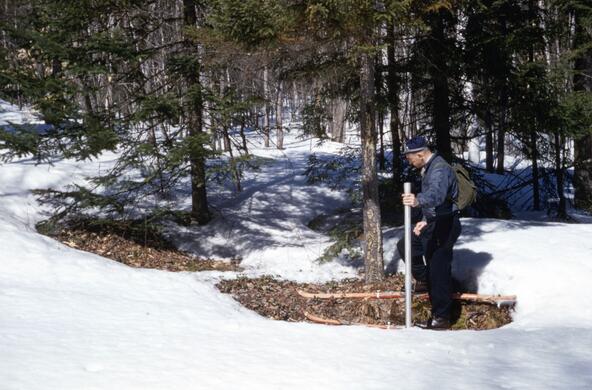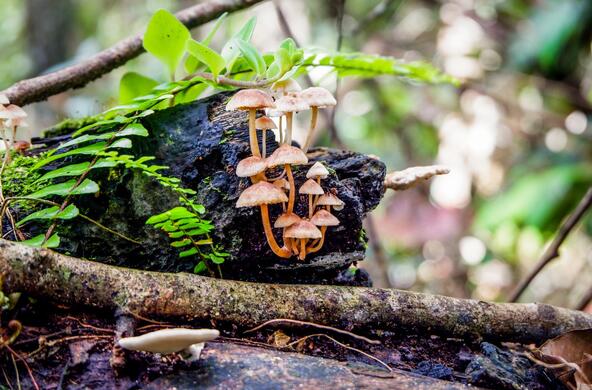Jane Lucas gingerly sticks a thermometer into the ground inside a small greenhouse, keeping an eye on the hornets’ nest just a few feet away from her face. Around her are rows and rows of shoulder-high wooden structures. Some have trapezoidal plexiglass enclosures, and some have sparse roofs overhead; here and there are bare patches where the grass grows longer than the mowed walkways in between.
These 1.5 meter-square plots of land — all 80 of them — form the first phase of Stressed Out Soils, a 10-year project where Lucas is studying how a variety of global factors are affecting soil health. Findings will reveal strategies to help farmers maintain healthy soils and maximize soil carbon storage in the rapidly changing Hudson Valley and beyond.

Scientists know of many factors that are stressing out our soils. They include warming temperatures, drought, antibiotics from wastewater or cow manure, and fungicides, often used to protect agricultural crops. But so far, those variables have primarily been studied one at a time. Lucas’ experiment is the one of the first to combine those variables and see how they interact. Will they exacerbate each other, or will some cancel out one anothers’ impacts?
To find out, Stressed Out Soils is testing 16 different combinations of those stressors — warming, drought, antibiotics, and fungicides. The plexiglass enclosures block wind and trap heat, leading to higher temperatures. The scant roofs funnel away some rain, simulating drier conditions. And the crew applies antibiotics and fungicides to select plots each month. Some plots are exposed to only one of these stressors. Others have two or three, and a few plots are hit with all four stressors at once.
Hornets are not part of the study, but they’ve unfortunately taken up residence in two of the plots. “They hate it when I open the enclosure,” says Lucas. As she takes notes on a clipboard, a few of the insects buzz past her on their way back to a nest that’s about the size of a Thanksgiving turkey.
Nearby, another buzzing sound comes from a machine that’s measuring how much carbon dioxide the soil microbes are putting off. The machine clamps over a large PVC pipe in the center of each plot and sucks up air from the soil, through tubes, and into a bright yellow briefcase that analyzes the gases inside. The amount of CO2 it collects tells Lucas about the health of the soil’s microbes, which play vital roles in nutrient cycling, decomposition, and stimulating plant growth.
“If the microbes are really stressed, then they might be ‘breathing’ a lot more, as if they were having to run around,” Lucas explains. “It's a lot more work to just maintain themselves when the soil conditions aren’t optimal.”

Since the project kicked off in the summer of 2022, Lucas and her team — which includes talented research technicians, volunteer ecologists, and eager high school and undergraduates beginning their science careers — have been rigorously collecting a host of data from each plot. Every few weeks, they measure the CO2 output, and take soil samples to identify which bacteria and fungi are present. Plant height is checked on a monthly basis, and they assess plant composition at the beginning and end of each growing season. “That tells us, for example, if we knocked out the soil fungi, does that mean we've also knocked down our plant diversity?” says Lucas.
The team has already made a few surprising observations. “The warming chambers are significantly more lush,” says Lucas, pointing to a steamy enclosure filled with tall plants, like a miniature jungle. And the rain-sheltered plots seem to be thriving better than the roofless ones — perhaps because of the region’s unusually wet summer.
“The unsheltered plots are often our shortest-growing plots,” says Lucas. “I don’t know what’s driving that, to be honest. But that’s science. Things don’t always work the way you thought they would, and that’s part of the learning process.”
In October, she shared other preliminary results, some of which were also counterintuitive. For plots with only one type of stressor, fungicide, drought, and warming decreased the amount of CO2 coming off of plots — meaning they had lower microbial activity — whereas bactericidal plots were giving off more CO2.
But when bactericide was combined with warming, CO2 production was much higher than in the controls. “They’re not canceling each other out,” Lucas explains. “They’re coming together to magnify an effect.”
And while warming, drought and fungicide alone each decreased CO2 production, when you put them all together, they increase the amount of CO2 production.
“The big take-home point is that these treatments are not following a consistent additive pattern,” she says.
Still, she cautions, it will be several years before the team will be able to pick out reliable trends in the data.
Lucas has ambitious plans for scaling up the experiment to explore the impacts of pesticides as well, and to see what happens when the treatments occur in sequence over longer time periods, rather than simultaneously. For example, because the Hudson Valley has historically been a dairy farming area, and dairy farmers typically use antibiotics to keep their cows healthy, many soils in the region have been exposed to antibiotics. Lucas hopes to find out how well the soils recover long after these disruptions to the soil microbiome.
In the future, she’d also like to extract the below-ground invertebrates, to see how the stressed out soils impact other parts of the food web.
Next summer, they’ll pump in a special type of carbon dioxide into the ground of each plot. The CO2 will contain a rare isotope of carbon — C13 — that will allow the team to trace how the various stressors shape carbon cycling across soil, microbes, and plants. Do they lead to more below-ground carbon storage? Will they increase the amount of carbon that the plants take up? Or will the carbon just rapidly return to the atmosphere? Lucas is particularly interested in seeing how antibiotics and antifungals affect the ability of the ecosystem to absorb excess carbon.
“A huge question in the soil science world is: How much more carbon can we put in soil?” she says. “Knowing the capacity of your soils and how past stress might be affecting your ability to increase carbon in your soils is going to be a key question to answer, and we will start to get at that.”
The ultimate goal of Stressed Out Soils is to help farmers in the region anticipate the challenges ahead, and develop strategies to adapt. Lucas has built strong partnerships with local farmers, the USDA’s Natural Resource Conservation Service, Cornell Cooperative Extension, and Dutchess Land Conservancy to help share the project’s findings and recommendations.








